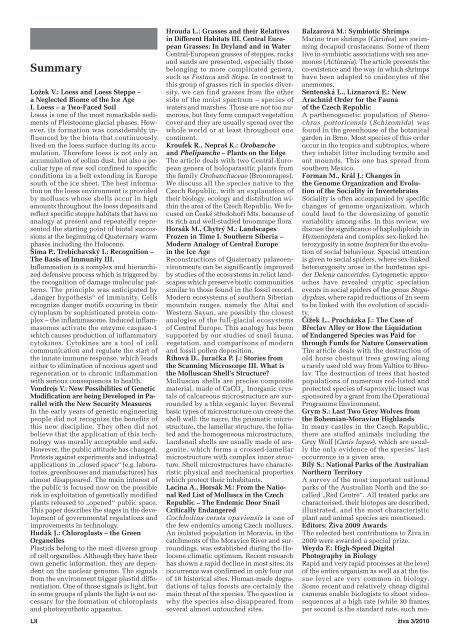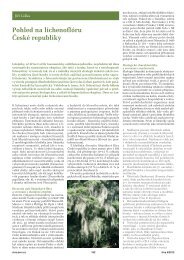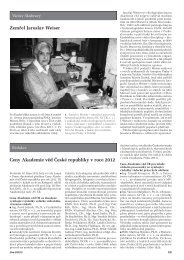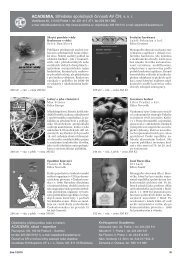Článek v PDF ke stažení - Živa - Akademie věd ČR
Článek v PDF ke stažení - Živa - Akademie věd ČR
Článek v PDF ke stažení - Živa - Akademie věd ČR
Create successful ePaper yourself
Turn your PDF publications into a flip-book with our unique Google optimized e-Paper software.
Summary<br />
Ložek V.: Loess and Loess Steppe –<br />
a Neglected Biome of the Ice Age<br />
I. Loess – a Two-Faced Soil<br />
Loess is one of the most remarkable sediments<br />
of Pleistocene glacial phases. How -<br />
ever, its formation was consi derably in -<br />
fluenced by the biota that con tinuously<br />
lived on the loess surface during its accumulation.<br />
Therefore loess is not only an<br />
accumulation of eolian dust, but also a pe -<br />
culiar type of raw soil confined to specific<br />
conditions in a belt extending in Europe<br />
south of the ice sheet. The best informa -<br />
tion on the loess environment is provided<br />
by molluscs whose shells occur in high<br />
amounts throughout the loess deposits and<br />
reflect specific steppe habitats that have no<br />
analogy at present and repeatedly represented<br />
the starting point of biotal succes -<br />
sions at the beginning of Quaternary warm<br />
phases including the Holocene.<br />
Šíma P., Trebichavský I.: Recognition –<br />
The Basis of Immunity III.<br />
Inflammation is a complex and hierarchized<br />
defensive process which is triggered by<br />
the recognition of damage molecular patterns.<br />
The principle was anticipated by<br />
„danger hypothesis“ of immunity. Cells<br />
recognize danger motifs occuring in their<br />
cytoplasm by sophisticated protein complex<br />
– the inflammasome. Induced inflammasomes<br />
activate the enzyme caspase-1<br />
which causes production of inflammatory<br />
cytokines. Cytokines are a tool of cell<br />
communication and regulate the start of<br />
the innate immune response, which leads<br />
ei ther to elimination of noxious agent and<br />
regeneration or to chronic inflammation<br />
with serious consequences to health.<br />
Vondrejs V.: New Possibilities of Gene tic<br />
Modification are being Developed in Pa -<br />
ral lel with the New Security Measures<br />
In the early years of genetic engineering<br />
people did not recognize the benefits of<br />
this new discipline. They often did not<br />
believe that the application of this technology<br />
was morally acceptable and safe.<br />
However, the public attitude has changed.<br />
Protests against experiments and industrial<br />
applications in „closed space“ (e.g. laboratories,<br />
greenhouses and manufactures) has<br />
al most disappeared. The main interest of<br />
the public is focused now on the possible<br />
risk in exploitation of genetically modified<br />
plants released to „opened“ public space.<br />
This paper describes the stages in the development<br />
of governmental regulations and<br />
improvements in technology.<br />
Hudák J.: Chloroplasts – the Green<br />
Organelles<br />
Plastids belong to the most diverse group<br />
of cell organelles. Although they have their<br />
own genetic information, they are dependent<br />
on the nuclear genome. The signals<br />
from the environment trigger plastid diffe -<br />
rentiation. One of those signals is light, but<br />
in some groups of plants the light is not ne -<br />
cessary for the formation of chloroplasts<br />
and photosynthetic apparatus.<br />
Hrouda L.: Grasses and their Relatives<br />
in Different Habitats III. Central Euro -<br />
pean Grasses: In Dryland and in Water<br />
Central-European grasses of steppes, rocks<br />
and sands are presented, especially those<br />
be longing to more complicated genera,<br />
such as Festuca and Stipa. In contrast to<br />
this group of grasses rich in species diversity,<br />
we can find grasses from the other<br />
side of the moist spectrum – species of<br />
waters and marshes. Those are not too nu -<br />
merous, but they form compact vegetation<br />
cover and they are usually spread over the<br />
whole world or at least through out one<br />
continent.<br />
Kroufek R., Nepraš K.: Orobanche<br />
and Phelipanche – Plants on the Edge<br />
The article deals with two Central-Euro -<br />
pean genera of holoparasitic plants from<br />
the family Orobanchaceae (Broomrapes).<br />
We discuss all the species native to the<br />
Czech Republic, with an explana tion of<br />
their biology, ecology and distribution wi -<br />
thin the area of the Czech Republic. We fo -<br />
cused on České středohoří Mts. because of<br />
its rich and well-studied broom rape flora.<br />
Horsák M., Chytrý M.: Landscapes<br />
Frozen in Time I. Southern Siberia –<br />
Modern Analogy of Central Europe<br />
in the Ice Age<br />
Reconstructions of Quaternary palaeoenvironments<br />
can be significantly improved<br />
by studies of the ecosystems in relict land -<br />
scapes which preserve biotic communities<br />
similar to those found in the fossil record.<br />
Modern ecosystems of southern Siberian<br />
mountain ranges, namely the Altai and<br />
Western Sayan, are possibly the closest<br />
analogies of the full-glacial ecosystems<br />
of Central Europe. This analogy has been<br />
supported by our studies of snail fauna,<br />
vegetation, and comparisons of modern<br />
and fos sil pollen deposition.<br />
Říhová D., Juračka P. J.: Stories from<br />
the Scanning Microscope III. What is<br />
the Molluscan Shell’s Structure<br />
Molluscan shells are precise composite<br />
material, made of CaCO 3<br />
. Inorganic crys -<br />
tals of calcareous microstructure are surrounded<br />
by a thin organic layer. Several<br />
basic types of microstructure can crea te the<br />
shell wall: the nacre, the prismatic micro -<br />
structure, the lamellar structure, the foliated<br />
and the homogeneous microstructure.<br />
Landsnail shells are usually made of aragonite,<br />
which forms a crossed-la mellar<br />
microstructure with complex in ner structure.<br />
Shell microstructures have characteristic<br />
physical and me chanical properties<br />
which protect their inhabitants.<br />
Lacina A., Horsák M.: From the Na tio -<br />
nal Red List of Molluscs in the Czech<br />
Republic – The Endemic Door Snail<br />
Critically Endangered<br />
Cochlodina cerata opaviensis is one of<br />
the few endemics among Czech molluscs.<br />
An isolated population in Moravia, in the<br />
catch ments of the Moravice River and surroundings,<br />
was established during the Ho -<br />
locene climatic optimum. Recent research<br />
has shown a rapid decline in most sites; its<br />
occurrence was confirmed in only four out<br />
of 18 historical sites. Human-made degradations<br />
of talus forests are certainly the<br />
main threat of the species. The question is<br />
why the species also dis ap peared from<br />
se veral almost un touched si tes.<br />
Balzarová M.: Symbiotic Shrimps<br />
Marine true shrimps (Caridea) are swimming<br />
decapod crustaceans. Some of them<br />
live in symbiotic associations with sea anemones<br />
(Actinaria). The article presents the<br />
co-existence and the way in which shrimps<br />
have been adapted to cnidocytes of the<br />
anemones.<br />
Sentenská L., Líznarová E.: New<br />
Arachnid Order for the Fauna<br />
of the Czech Republic<br />
A parthenogenetic population of Steno -<br />
chrus portoricensis (Schizomida) was<br />
found in the greenhouse of the botanical<br />
garden in Brno. Most species of this order<br />
occur in the tropics and subtropics, where<br />
they inhabit litter including termite and<br />
ant mounds. This one has spread from<br />
southern Mexico.<br />
Forman M., Král J.: Changes in<br />
the Ge no me Organization and Evo lu -<br />
tion of the Sociality in Invertebrates<br />
Sociality is often accompanied by specific<br />
changes of genome organization, which<br />
could lead to the downsizing of genetic<br />
variability among sibs. In this review, we<br />
discuss the significance of haplodiploidy in<br />
Hymeno ptera and complex sex-lin<strong>ke</strong>d he -<br />
terozygosity in some Isoptera for the evolu -<br />
tion of social behaviour. Special attention<br />
is given to social spiders, where sex-lin<strong>ke</strong>d<br />
hetero zygosity arose in the huntsman spider<br />
De lena cancerides. Cytogenetic approa<br />
ches have revealed cryptic speciation<br />
events in social spiders of the genus Stegodyphus,<br />
where rapid re duc tions of 2n seem<br />
to be lin<strong>ke</strong>d with the evolu tion of sociality.<br />
Čížek L., Procházka J.: The Case of<br />
Břeclav Alley or How the Liquidation<br />
of En dangered Species was Paid for<br />
through Funds for Nature Conservation<br />
The article deals with the destruction of<br />
old horse chestnut trees growing along<br />
a rarely used old way from Valtice to Břeclav.<br />
The destruction of trees that hosted<br />
populations of numerous red-listed and<br />
protected species of saproxylic insect was<br />
sponsored by a grant from the Operational<br />
Programme Environment.<br />
Grym S.: Last Two Grey Wolves from<br />
the Bohemian-Moravian Highlands<br />
In many castles in the Czech Republic,<br />
there are stuffed animals including the<br />
Grey Wolf (Canis lupus), which are usually<br />
the only evidence of the species’ last<br />
occurrence in a given area.<br />
Bílý S.: National Parks of the Australian<br />
Northern Territory<br />
A survey of the most im portant national<br />
parks of the Australian North and the socalled<br />
„Red Centre“. All treated parks are<br />
characterised, their biotopes are described,<br />
illustrated, and the most characteristic<br />
plant and animal species are mentioned.<br />
Editors: <strong>Živa</strong> 2009 Awards<br />
The selected best contributions to <strong>Živa</strong> in<br />
2009 were awarded a special prize.<br />
Weyda F.: High-Speed Digital<br />
Photography in Biology<br />
Rapid and very rapid processes at the level<br />
of the entire organism as well as at the tissue<br />
level are very common in biology.<br />
Some recent and relatively cheap digital<br />
cameras enable biologists to shoot videosequences<br />
at a high rate (while 30 frames<br />
per second is the standard rate, such mo -<br />
LII živa 3/2010










